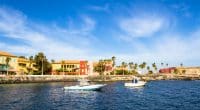The loan of US$138.5 million has been granted by the World Bank. The funding will enable state-owned power utility NamPower to prepare its grid for the integration of renewable energies.
The $138.5 million in financing recently approved by the World Bank comes from the International Bank for Reconstruction and Development (IBRD) Fund for Innovative Solutions in Global Public Goods and the Green Climate Fund (GCF). It will be used by the state-owned Namibia Power Corporation (NamPower) to implement a project to extend the electricity transmission and storage network.
Its overall aim is to prepare the Namibian power grid for the massive integration of renewable energies. NamPower will build the 458 km Auas-Kokerboom 400 kV transmission line. The high-voltage line will run from the 400 kV substation at Kokerboom (near Keetmanshoop) to the Auas substation near the capital Windhoek. The line, which will require an investment of $115 million, will run parallel to an existing power line to the south.
Electricity storage
In addition to integrating renewable energies, NamPower believes that the new line will improve the stability of its power grid. At the same time, the utility company headed by Kahenge Simson Haulofu will design, supply, install and commission a 100 MWh/25 MW battery storage system. This storage infrastructure should help NamPower to manage the variability of renewable energies and thus control fluctuating imports from Eskom, the South African electricity company.
Read also- Solar energy: Solarcentury to inject 60 MWp into the SAPP from southern Namibia
In addition, “our second utility-scale battery electricity storage system will be developed and integrated into our transmission network to support the development and adoption of renewable energy plants,” explains NamPower’s Managing Director. According to Kahenge Simson Haulofu, these investments will put Namibia on the path to sustainable development through the exploitation of its renewable energy sources.
In particular, the southern African country has immense solar potential, with 10 hours of sunshine a day for 300 days a year, according to the World Economic Forum (WEF). However, the country’s installed renewable capacity represents just over 30% of total production, estimated at 690 MW.
Jean Marie Takouleu







